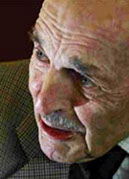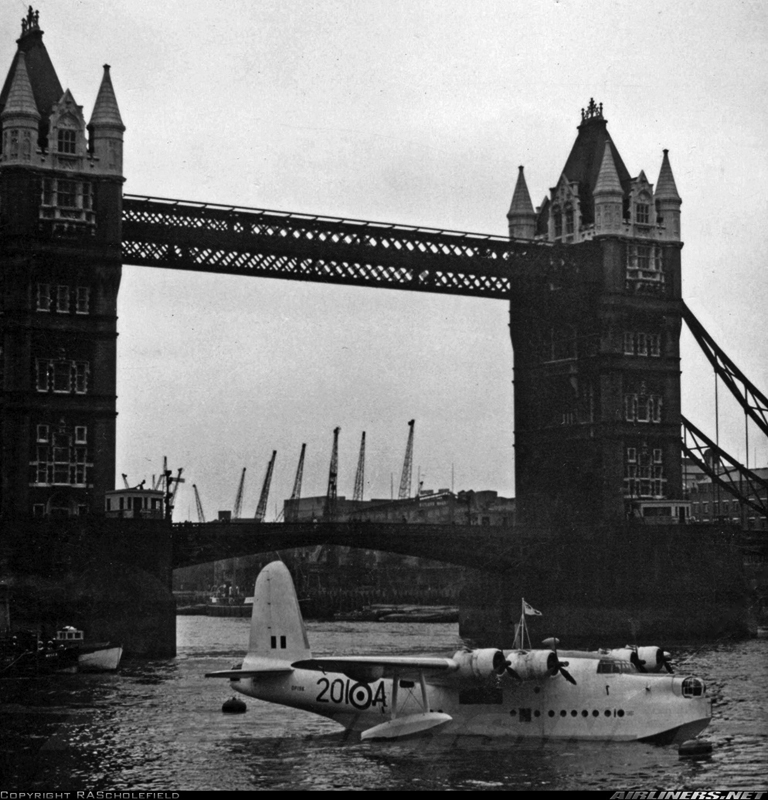
 Name : Alan Nicoll
Name : Alan Nicoll
Rank : Squadron Leader
Ser. No. : TBC
Dates at Cranage : Dec 1941 - Mar 1942
Instructor - No.2 S.o.A.N.
Mr Nicoll responded to a request for information, on RAF Cranage, in RAF News, that had been placed by Hugh ‘Budgie’ Budgen and I hope to be able to include a photograph of Mr Nicoll soon. Having been involved in the very first raid of WWII, Mr Nicoll completed a full tour of 37 raids before being commissioned and selected for advanced training in Canada. As a qualified Sunderland flying boat Captain he took the last R.A.F. aircraft to moor up in the Pool of London for the 1956 “Battle of Britain” celebrations. You can see a picture of this below.

201 Squadron's Sunderland 5 is moored in the River Thames next to Tower Bridge during the 1956 Battle of Britain week. Based at RAF Pembroke Dock, the aircraft had landed lower down the river and taxied here for exhibition. 201 Squadron retired their Sunderlands in February 1957, being replaced by Shackleton MR.3s. DP198 had been built as a Mark III by Shorts Windermere factory in December 1943.
The photograph shown above is used with kind permission of Mr R. A. Scholefield.
To see more photographs by Mr Scholefield please follow this link -
http://www.airliners.net/search/photo.search?photographersearch=R.A.Scholefield
Letter 1
08 - 09 - 2010
Your item in R.A.F. News brought back a memory to me of service 58 years ago. I cannot contribute much to R.A.F. Cranage history as my stay there was very short. The dates were from 27th December, 1941 - 18th March 1942 while serving as a Navigation Instructor at No.2 School of Air Navigation. I gave a few lectures but never did any flying.
I suspect it was a “holding” posting pending a decision on my future. I had first returned from Canada having completed a six months specialist course and my eventual fate was to be sent overseas in April 1942 to Southern Rhodesia. Here I instructed and subsequently returned home almost 3 years later having completed a pilots course.
I must also have time off at Cranage as I married my wife in Lincoln on 4th Jan 1942 and we had a short honeymoon in Bournemouth. I remember a very tedious journey by train from Lincoln to Holmes Chapel stopping at innumerable stations with a change at Crewe. I managed to live out with my wife in rooms at Mrs Sant’s house at 5 Ashfield Street, Middlewich. I remember it was very cold [snow] and sparse rations at the time made for a restricted diet.
We were happy together and we had a happy marriage lasting 62 years until she died 6 years ago, but I always thought it was the worst posting I ever had!!
It was nice having a chat with you.
With best wishes,
Alan Nicoll
Telegraph article
Now in my 89th year, I was one of the lucky survivors and retain a vivid memory of events 70 years ago.
I joined the RAF Ist February, 1939, aged 18, for training as an Observer, a resurrected aircrew category from the Great War. We passed out as Navigators qualified also in Bomb Aiming and Air Gunnery. My first posting was to 44 Squadron at RAF Waddington, arriving on 26th June, 1939 as Acting Sergeant. The squadron had just received new aircraft, the Handley Page Hampden, and a familiarisation programme had begun,
The first day of WWII was 3rd September, 1939, which was a Sunday. I was in the Sergeants’ Mess reading the newspapers after breakfast. The wireless was on and I heard Mr Chamberlain make the solemn announcement that we were ‘at war with Germany’.
Soon after this dramatic news we were told to assemble after lunch in the Operations Room. The outcome of an address by the Station Commander was that 9 Hampdens from 44 Squadron were to carry out a low level attack that evening as part of a joint force with 9 Hampdens from Scampton. The targets were warships at Wilhemshaven. Our force was to be led by our much respected C.O Wing Commander John Boothman. He had won the Schneider Trophy for Britain.
I was details as one of the navigators. I was 19 years old, with a total of 86 hours’ flying experience, six being at night. Strangely, I cannot remember any particular emotion, either feeling apprehensive or frightened. One had to go with the tide so I resigned myself to my fate with the naïve thought that it will ‘never happen to me’
As to the raid itself, a paragraph in The Hampden File, an excellent book by Harry Moyle who was a student with me, expresses things perfectly. I quote:
“Indecision about the type of bomb to be used in the attack caused delays in the time of take-off, and it was after 1800 hours before the two separate formations had become airborne. Neither reached the target area before darkness descended, so no aircraft was able to make an attack. Most of the 18 pilots involved had never flown a Hampden at night before, and none had taken off with a full load. Even though the operation achieved no military success and the return flight across the North Sea was an undignified straggle follow-my-leader with navigation lights switched on, it is a tribute to the pilots that all the aircraft were safely back on the ground by around midnight.”
After landing we returned to the crew room where everyone indulged in a some whisky, a practice which was never repeated!
Neither disaster nor success, I’m afraid, but on the positive side lessons were learned. Much more training was obviously required. It was 21st December before raid number two and due to a hard winter with much snow on the grass airfield and for me an Astro Nav course, it was June 1949 before I was involved in further operations on a nightly basis.
I completed 35 operational sorties – reconnaissance sweeps over the sea, mine laying, and bombing. Two of the last were to Berlin – extreme range for the Hampden – my last contact with the enemy being on 14th October 1949. Youthful naivety proved correct as fate dealt kindly with me and I survived unscathed. I received commission, was posted as an Instructor to Southern Rhodesia and eventually returned having also completed a pilot’s course. By this time the war was over, but I stayed in the service and retired in 1975.
All material on the web site is covered by copyright © 2010 - 2016